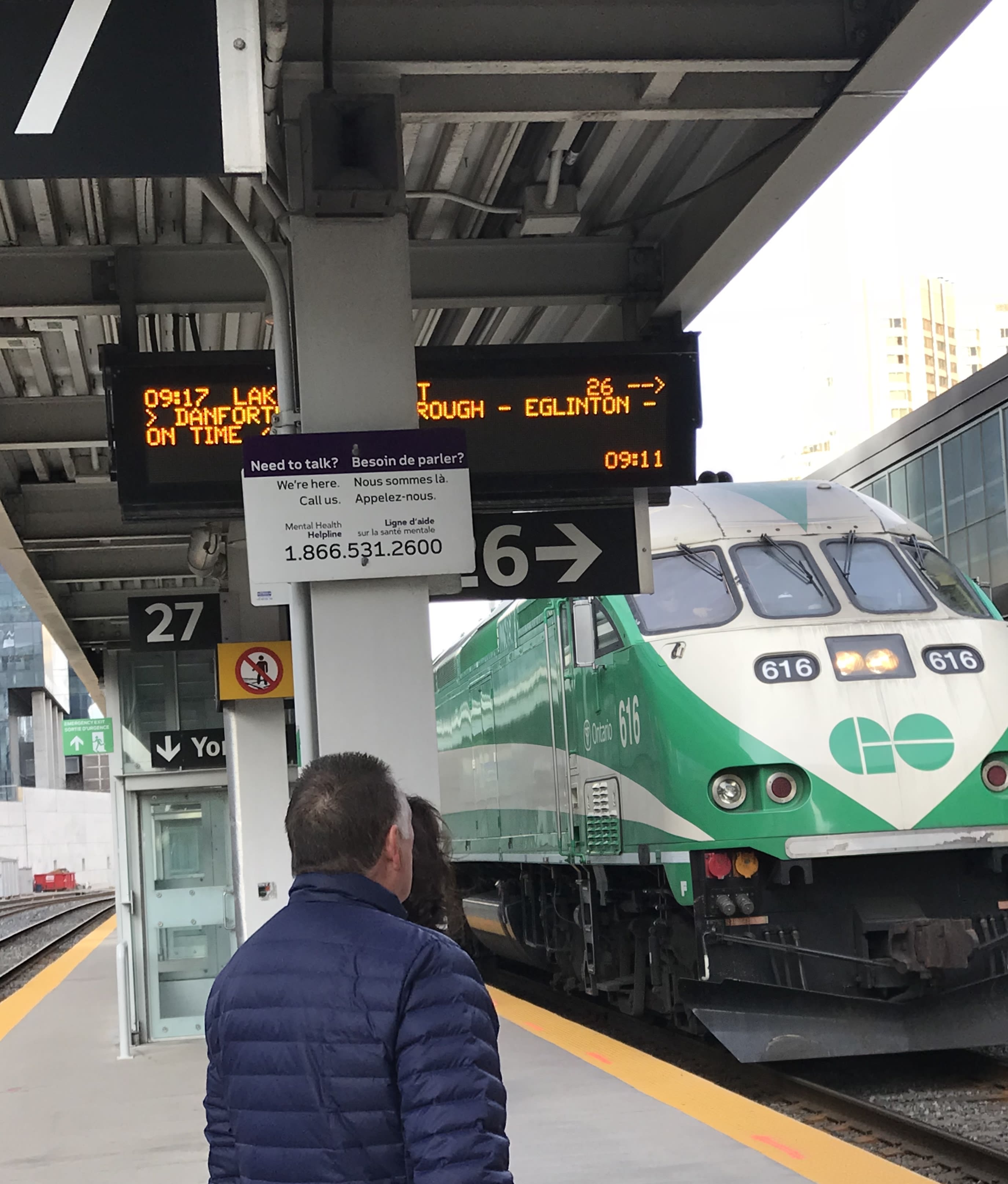Shining a light on suicide prevention across GO network
Metrolinx speaks in frank and honest terms about suicides on train and bus routes.
Sep 10, 2019
It is the most awful type of familiar.
Those who work for public transit agencies are sadly all too familiar with the devastating aftermath of suicide and the long-term impact it has on loved ones, first responders, witnesses and the entire community.
The human toll of lasting emotion, enduring devastation and personal loss is almost unfathomable. But we do know the hard numbers of incidents. Each year, on average, more than a dozen people die by suicide on Metrolinx rail corridors.
Metrolinx has a partnership with ConnexOntario. Hundreds of signs are placed throughout the system. Shown here as a couple wait to board a GO train.
Now, an even more disquieting tally and truth – so far in 2019, the number is higher than our usual average. And we’re also seeing more young people die by suicide on our tracks.
These tragic and worrisome trends keep many of us awake at night. What more can we say and do? How do we increase the volume of urgency and also reach those who are troubled and need a human connection?
We know we are not alone in our struggle to find these answers.
According to the International Association of Suicide Prevention (IASP), curbing these tragedies remains a universal challenge. Every year, suicide is among the top 20 leading causes of death for people of all ages, and is responsible for more than 800,000 deaths worldwide.
Count down 40 seconds. Now take a breath. In that span, someone takes their life somewhere on Earth – and millions of lives are changed forever.
IASP organizes World Suicide Prevention Day (#WSPD) annually on this date (Sept. 10) as an opportunity to collectively shine a light on suicide prevention, both personally and at a community level.
This year’s theme, Working Together to Prevent Suicide, is an opportunity to raise awareness around the globe that we can all make a difference in the lives of those who might be struggling.
There is no simple answer to preventing suicide. The work continues while a single life is at risk.
“With more than 500 kilometres of open rail, we prevent access as much as possible through a variety of measures,” said George Bell, Metrolinx’s vice present of Safety and Security with Metrolinx, as well as chair of our Suicide Prevention Working Group.
“We also train our staff to recognize the signs of someone considering suicide. Transit safety officers reach out to spark a conversation. Through hundreds of signs across our rail corridors, we ensure those contemplating suicide have access to crisis assistance.”
Transit safety officers are on the frontlines and are often the first people to see someone facing a mental health crisis. They receive specialized annual crisis intervention training to be equipped when someone is facing a mental health crisis.
On average, transit safety officers receive approximately 10-15 calls per month for mental health interventions. About 30 per cent of those are suicide related.
So far in 2019, transit safety and station staff have intervened in more than 60 cases of people who were in distress and considering suicide. That’s 60 lives potentially saved.
“We all have a role to play,” said Bell.
“It is our goal to train all of our staff in interventions. We can create productive and meaningful solutions to drive suicide rates down.”
Metrolinx has also increased efforts to acknowledge the tragedies publicly and remove the stigma of talking about suicide. By using transparent and compassionate language and responsibly linking to services available, we hope to foster understanding and conversations around mental health and suicide prevention.
We also make sure that our staff has the support they need. Metrolinx has a Peer Support Program available on call 24/7 to assist officers following a tragic incident. Part of creating the right system to support front-line staff is ensuring Metrolinx leadership understands.
New this year, Metrolinx has formed the Suicide Prevention Working Group – with staff across divisions – that is developing other prevention strategies. In future Metrolinx News stories, we’ll be expanding on details of that suicide prevention strategy.
Everyone can make the difference in someone’s life. There are great resources provided by the Distress Centres of Greater Toronto that are extremely helpful in creating greater awareness and building understanding for both people who are considering suicide and for those who are in a position to help a person suffering. Click here to see their site.
We know our stories about suicide can be difficult to read — whether you’re grappling with your own feelings of hopelessness or reminded of an experience you’ve had in the field as a transit worker. They can be triggering and upsetting. ConnexOntario is there to help, call 1-866-531-2600. You can also call your nearest hospital or call 911.
These are the toughest conversations to have. But being familiar with the outcome and cost just makes it even more critical.
by Anne Marie Aikins Chief spokesperson
